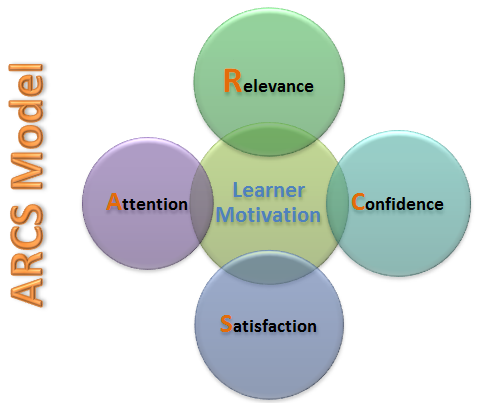Strategies for Teaching Your Course
| Site: | Technology-Enabled Learning Lounge |
| Course: | Developing & Teaching Online Courses |
| Book: | Strategies for Teaching Your Course |
| Printed by: | Guest user |
| Date: | Wednesday, 3 December 2025, 12:45 AM |
Description
Teaching online is not the same as teaching in a classroom environment. This book will introduce you to effective strategies to teach online, keeping learners engaged and motivated.
Online Teaching
Michael Feldstein, e-learning consultant, in one of his blog posts stated that:
Teaching online is completely different. There is no stage. You have no captive audience. You have no ability to lean on your physical presence and stagecraft as a teacher. What you do have is the wide world that the student is immersed in, and the student’s imagination and initiative. So that’s what you use.
Undoubtedly, the "sage on the stage" will morph into the "guide on the side" in an online environment. Online tools, and especially the Internet, offer endless possibilities for instructors to stimulate learners and engage them in active learning processes. Online teaching is underpinned by a different pedagogical paradigm, where learning is learner-centred and learners are engaged in active learning experiences that guide them through critical thinking and the construction of meaning as they interact with the world around them and their peers. Instructors become the guides on the side as they monitor the learning experience and intervene as guidance is necessary. However, fostering learning online is no easy task. Instructors need to tap into the intrinsic and extrinsic motivation of their learners to keep them engaged.
The following resources share best practices in online teaching and offer a number of strategies and tips to teach effectively in online and blended environments.

Web Resources: Optional Readings
- Ten best practices for teaching online
- Ten lessons learned about online teaching
- Guidelines for online teaching success
- Seven principles for good practice in the online classroom
- Ten principles of effective online teaching: To access this report you will have to create an account in Faculty Focus. It's a vibrant community of educators that explores issues of teaching and learning, online and in the classroom, so you may want to consider joining.
- Seven principles of effective teaching: evaluating online courses

Discussion
Think about your own experiences being an online learner and take some time now to participate in the Sharing Online Learning Experiences discussion, where you will share your thoughts on what worked and didn't work for you.
Fostering Learning Online
Fostering meaningful learning online requires an understanding of online learners and their motivation to learn.
Motivation
 Keller (1991) stated that to keep learners motivated to learn instructors need to:
Keller (1991) stated that to keep learners motivated to learn instructors need to:
- gain learners attention: to gain attention you can use different instructional techniques, such as discovery learning, videoquests, twitter discussions. One other way of gaining attention may be to centre a discussion around something controversial, but relevant to the learning (e.g. newspaper articles about safety if you are teaching carpentry)
- make the content relevant: use examples and design activities that are contextual and relevant to the learners (e.g. if you are teaching auto mechanics, come up with activities that will involved fixing car breaks)
- ensure learners are confident that they can succeed in learning the course content: make sure that all activities and assessments are "doable" and present your content in manageable chunks
- satisfy the learners’ need for value in learning the material: provide timely and frequent feedback to your learners so that they have a sense of accomplishment.
Online Facilitation
The ARCS model applies not only to online course design but also to online facilitation of learning, through discussions, for example.
Tips for online facilitation
- Instructor presence: Make sure your presence as an instructor is felt throughout the course. Not just in the content you create, but also when you facilitate discussions. This doens't mean that you have to respond to every single post in the discussions, Quite the opposite - you will get more value for your postings when you post when necessary to provide guidance or to re-assure learners that they are on the right track.
- Weaving: Use the 'weaving' technique to recognize learners' contributions to the discussion, to link key concepts discussed and to pose further questions if appropriate. Weaving through contributions is an example of extrinsic motivation and may result in subsequent postings. 'Weaving' technique is based on a single reply to several postings and creates opportunities for the instructor to guide the direction of the discussions, to summarize the main points or to pose further questions to delve deeper into a topic.
- Summarizing: Summarizing the main themes that surface in a discussion helps consolidate the learning and establish a connection with the content. You can do the summaries yourself, however, consider assigning the task to learners as a way to further engage them in the discussion. This can be done in the form of 'homework' and can be for marks or not.
- Guest speakers: Bringing guest speakers to participate in your online discussions brings relevance to your topic and encourages learner engagement.
- Debates: Debates are a good way to explore topics through polarization. Debates tend to be engaging by nature, as you prompt learners to take a position on a topic. Typically, for an online debate, you split your class into two groups and assign them a position (in favour or against).
- Examples: Integrate relevant examples in your posts whenever possible. It makes the posting relevant and provides learners' with context.

Examples
Here is a good example of weaving:
"Topic: 1 – Principal Leadership -
Author: Richard: However disappointed I have been this year because my job did not turn out to be what I thought it was going to be, I have managed to grow tremendously as a future administrator. This opportunity has been afforded me because of my job flexibility and willingness to hunt for extra things to take on. Teachers were bringing students to my attention that they felt needed extra help, and I would help those students, but more importantly I helped the teachers, too. It became apparent to myself and the administration that I was going to be a great service to them in bringing about the change they desired.
Author: Jeffrey: My mentor said that his vision of leadership and his actual job have become almost completely data driven with the effects of No Child Left Behind. He looks to his key teachers for ideas about curriculum and teaching. He lets them respond with their thoughts and ideas and then continues to develop a vision. Hopefully, the staff and students will gain an ownership of the vision. I’m not sure I want to be this ‘driven’ by numbers and statistics when I become a principal, although I know they are important.
Author: Kelley: Your mentor seems very experienced and professional. Also, very realistic about the aspects of public education. Both of you mention getting to know your key staff members. Your administrator inferred some behaviors that I believe are very important for a principal. Those include: modeling behavior, encouraging a positive learning environment, and following through. Often I have felt my previous administrator did not display this behavior. Many times I was left feeling nothing but frustration!
Author: Jo Marie: Jeff, I agree that it takes multiple people to develop a school vision. I think I disagree with your mentor about vision being mostly data driven as a result of NCLB. A lot of factors have to be taken into consideration when developing a vision for a school. Data is good to prove the need, but you must also consider the demographic area and needs of your students and staff as well.
Author: Allen: Well, I think the principal’s leadership starts with a vision. I mean, it’s not his or her own personal vision – I think it needs to be developed by a group of stakeholders from the school. But, when Richard talked about making change happen for the teachers, shouldn't a vision already be in place to help guide the decisions and actions of the principals and teachers? I’m not sure where data fits into the picture….
INSTRUCTOR’S WEAVING OF RESPONSES (to briefly summarize each student’s ideas):
Dear Richard, Jeffrey, Kelley, Jo Marie, and Allen: Thank you for your initial postings to Assignment 1 on “Principal Leadership.” We certainly have a nice variety of thoughts and ideas, which I’m sure comes from all of our varied backgrounds! All of you have basically addressed how the Principal’s leadership can affect the school, the teachers, and the students. Richard mentioned how he has been able to assist teachers with specific student learning issues (which is exactly what a principal does); Jeffrey, Jo Marie, and Allen focused on the all-important concept of vision; and Kelley spoke of a positive learning environment as well as the Principal being the model for certain behaviors. If we could all focus on the idea of creating a shared VISION for a moment, how would each of you define the role of the Principal in shaping the vision for the school community? When you each post your response, please be concise, responding in 1 or 2 sentences. I look forward to reading your responses!" Connexions
The following resources provide best practices and tips for the facilitation of online discussions

Web Resources: Optional Readings
- Do's and Don'ts of Online Facilitation: CC BY NC SA
- Creating Effective Summaries: CC BY NC SA
- Capabilities of Online Facilitators: CC BY NC SA
Engaging in Discussions
When teaching in an online and blended environment, asynchronous discussions are a good way to keep your learners actively engaged in the learning process. However, discussions can also be a burden for students, especially if they are over-used in a course and if your students are taking multiple online courses. 'Discussion fatigue' is an online course syndrome caused by too many discussion forums in a course with minimum posting requirements. In these cases, the result you get is that learners become passively engaged and make postings because they have to, especially if the discussion mark counts towards the final grade.
So what is too much? Well, like in any teaching and learning, there is no right or wrong answer. It depends on the course design, the course content (sometimes courses are taught based on discussions) and on the learner circumstances (if you know that your learners are enrolled in a full-time program of study, perhaps it may be best to check on the participation requirements of other courses and keep the requirements for your own course in check). Having said this, a good rule of thumb is to make sure that you keep your students engaged by having them come to the course site to participate at least every two weeks. So, in a 10 week course you may have four or five discussions.
Keeping Learners Engaged
Here are a few strategies that you can use to keep your students engaged in the discussion activities:
Use students to lead the discussion:
- Have students synthesize the weekly postings.
- Have students suggest a relevant topic discussion and let them moderate. Students may submit one question to you via e-mail for consideration. You select the question that is most relevant and have the student who submitted the question be the moderator for that discussion.
- Assign a group to be the experts on a topic or section. Have them post a question for discussion and lead the discussion. Toward the end of the class discussion, have the discussion leaders summarize and combine points for their classmates.
Promote interaction:
- Create debates by having students take sides on an issue and defend their positions. In blended environments you may poll students in class on a particular topic. Then you can have students support their positions in the online discussion area.
- Post a number of questions relating to a course topic. Assign students to work in small groups on these questions. Each group will then post their final results to the discussion.
- In blended environments, post a discussion question related to course readings prior to the in-class discussion. You can use comments from the online discussion to generate in-class discussion. This will help students prepare for the face-to-face discussion.
Before Your Course Starts
So... your course is ready to go: all content is up, all activities have been developed, all assignments are ready... It is now time to write a module that will orient learners to the course.
The Orientation Module
The purpose fo the orientation module is to ensure that students have all the information about the course in one place. This modules should include sections about:
- Course overview
- How to get technical assistance
- Telephone number
- Email address
- Website
- How to contact tutor
- Hours
- Different ways of contact (email, skype, etc.)
- Links to any learner support materials available on campus
- Links to library if appropriate
- How the course is structured
- Number and name of modules
- How to work through the course
- Navigating the course site
- Study tips
- Explanation about modules activities and discussions
- Outline of learner assessment and self-assessment
- Links to policies, such as academic conduct if applicable
Assignment
Taking the Getting Started module in this course as an example, create an orientation module for your course.
The Introduction E-mail
One week before the course starts, you should send an introduction email to all the enrolled students in your course. The purpose of this email is to let yous students know how to login and what to expect of teh course. It is also a great way to establish a connection with the learners as you provide them with some information about yourself as the tutor/instructor.

Example
This sample email message is a good example of an introductory email. feel free to edit it and adapt it to your own needs.
And with this, you conclude the study of this course. We hope that by now you are well on your way to having your online or blended course implemented in Moodle. Best of luck with teaching your course!